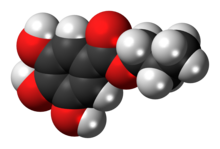Propyl gallate

| |

| |
| Names | |
|---|---|
| IUPAC name
Propyl 3,4,5-trihydroxybenzoate
| |
| Other names
Gallic acid, propyl ester
n-Propyl gallate E310 | |
| Identifiers | |
3D model (JSmol)
|
|
| ChEMBL | |
| ChemSpider | |
| ECHA InfoCard | 100.004.090 |
| EC Number |
|
| E number | E310 (antioxidants, ...) |
| MeSH | Propyl+Gallate |
PubChem CID
|
|
| UNII | |
CompTox Dashboard (EPA)
|
|
| |
| |
| Properties | |
| C10H12O5 | |
| Molar mass | 212.20 g/mol |
| Appearance | White crystalline powder |
| Melting point | 150 °C (302 °F; 423 K) |
| Boiling point | Decomposes |
Except where otherwise noted, data are given for materials in their standard state (at 25 °C [77 °F], 100 kPa).
| |
Propyl gallate, or propyl 3,4,5-trihydroxybenzoate, is an ester formed by the condensation of gallic acid and propanol. Since 1948, this antioxidant has been added to foods containing oils and fats to prevent oxidation.[1] As a food additive, it is used under the E number E310.
Description
[edit]Propyl gallate is an antioxidant. It protects against oxidation by hydrogen peroxide and oxygen free radicals. It appears as a white to creamy-white crystalline odorless solid.[2][3]
Propyl gallate (PG) is a white to nearly white odorless crystalline powder that has slightly bitter taste and darkens in the presence of iron salts. It is an irritant that can cause skin dryness, dermatitis, and sensitization. Inhalation may cause chemical pneumonia
Production
[edit]Propyl gallate does not occur naturally, and is prepared either from reactions with gallic acid and 1-propanol, or by enzyme catalysis of tannic acid.[4] Syntheses with gallic acid have been the most prominent methods of production, and include Steglich esterification with N,N'-diisopropylcarbodiimide and 4-dimethylaminopyridine, anhydrous addition of thionyl chloride, and Fischer esterification with various catalysts.[5]
Uses
[edit]Propyl gallate is used to protect oils and fats in products from oxidation; it is used in foods, cosmetics, hair products, adhesives, biodiesel, and lubricants.[6] It is often used interchangeably with octyl gallate and dodecyl gallate in these applications.[3]
Propyl gallate is an antioxidant that neutralizes free radicals, which are unstable molecules that can damage cells, proteins, and DNA. It is used as a triplet state quencher and an antioxidant in fluorescence microscopy.[7]
Biological effects
[edit]A 1993 study in fat rodents found little or no effect on carcinogenesis by propyl gallate.[8]
A 2009 study found that propyl gallate acts as an estrogen antagonist.[9]
Propyl gallate has many biological activities, including:
- Enzyme inhibition
- Antimicrobial activity
- Inhibition of nitrosamine formation
- Anticarcinogenesis
- Antitumorigenesis
- Anesthesia
- Anti-nociceptive
- Inhibition of biosynthetic processes
- Ionizing/ultraviolet (UV) radiation protection
Safety
[edit]- Propyl gallate is an irritant to the skin and eyes, and it can be inhaled. Some studies have reported that propyl gallate is toxic, while others have reported therapeutic benefits.
- The FDA recognizes propyl gallate as being generally safe, but in other countries, it's either been used on a very limited basis or completely banned. This is because some preliminary studies have suggested that propyl gallate may cause cancer (in several organs) in rats and be an endocrine disrupter.[10]
References
[edit]- ^ "Final Report on the Amended Safety Assessment of Propyl Gallate". International Journal of Toxicology. 26 (suppl. 3): 89–118. 2007. doi:10.1080/10915810701663176. ISSN 1091-5818. PMID 18080874. S2CID 39562131.
- ^ Gálico, D. A.; Nova, C. V.; Guerra, R. B.; Bannach, G. (2015-09-01). "Thermal and spectroscopic studies of the antioxidant food additive propyl gallate". Food Chemistry. 182: 89–94. doi:10.1016/j.foodchem.2015.02.129. ISSN 0308-8146. PMID 25842313.
- ^ a b EFSA Panel on Food additives and Nutrient Sources added to Food (ANS) (2014). "Scientific Opinion on the re-evaluation of propyl gallate (E 310) as a food additive". EFSA Journal. 12 (4). doi:10.2903/j.efsa.2014.3642.
- ^ Nie, Guangjun; Liu, Hui; Chen, Zhen; Wang, Peng; Zhao, Genhai; Zheng, Zhiming (2012). "Synthesis of propyl gallate from tannic acid catalyzed by tannase from Aspergillus oryzae: Process optimization of transesterification in anhydrous media". Journal of Molecular Catalysis. 82: 102–108. doi:10.1016/j.molcatb.2012.06.003. ISSN 1381-1177.
- ^ Nguyen, Van Hai; Le, Minh Ngoc; Nguyen, Hoa Binh; Ha, Kieu Oanh; Pham, Thai Ha Van; Nguyen, Thi Hong; Dao, Nguyet Suong Huyen; Nguyen, Van Giang; Nguyen, Dinh Luyen; Trinh, Nguyen Trieu (2021-04-12). "Propyl Gallate". Molbank. 2021 (2): M1201. doi:10.3390/M1201. ISSN 1422-8599.
- ^ Hosseinzadeh-Bandbafha, Homa; Kumar, Dipesh; Singh, Bhaskar; Shahbeig, Hossein; Lam, Su Shiung; Aghbashlo, Mortaza; Tabatabaei, Meisam (2022-07-01). "Biodiesel antioxidants and their impact on the behavior of diesel engines: A comprehensive review". Fuel Processing Technology. 232: 107264. Bibcode:2022FuPrT.23207264H. doi:10.1016/j.fuproc.2022.107264. ISSN 0378-3820.
- ^ Jerker Widengren; Andriy Chmyrov; Christian Eggeling; Per-Åke Löfdahl & Claus A. M. Seidel (2007). "Strategies to Improve Photostabilities in Ultrasensitive Fluorescence Spectroscopy". The Journal of Physical Chemistry A. 111 (3): 429–440. Bibcode:2007JPCA..111..429W. doi:10.1021/jp0646325. PMID 17228891.
- ^ Hirose, Masao, et al.. "Modification of carcinogenesis by α-tocopherol, t-butylhydro-quinone, propyl gallate and butylated hydroxytoluene in a rat multi-organ carcinogenesis model." Carcinogenesis 14.11 (1993): 2359-2364.
- ^ Alessio Amadasi; Andrea Mozzarelli; Clara Meda; Adriana Maggi; Pietro Cozzini (2009). "Identification of Xenoestrogens in Food Additives by an Integrated in Silico and in Vitro Approach". Chem. Res. Toxicol. 22 (1): 52–63. doi:10.1021/tx800048m. PMC 2758355. PMID 19063592.
- ^ "5 Preservatives to Avoid | MDVIP". www.mdvip.com. Retrieved 2024-10-10.
